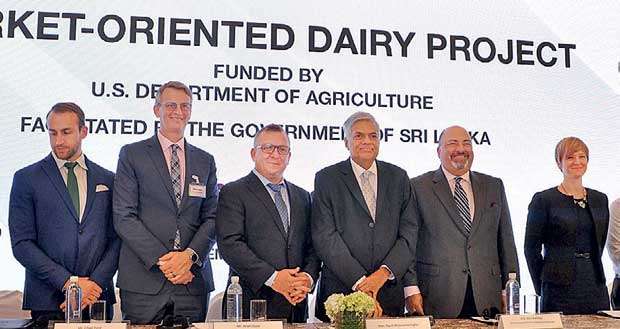18 May 2018 - {{hitsCtrl.values.hits}}

From left: Food for Progress Asia, Team Lead, Thomas Szymanski, Associate Vice President of IESC, Chad Ford, United States Department of Agriculture (USDA), Assistant Deputy Administrator, Brian V. Guse, Prime Minister, Ranil Wickremesinghe, US Ambassador to Sri Lanka and Maldives, Atul Keshap and US Department of Agriculture, International Program Specialist, Caitlyn Cackoski . Pic by Nisal Baduge
By Nishel Fernando
Sri Lanka aims to double its dairy production by enhancing the small and medium dairy farmers’ productivity and competitiveness through a US $14.1 million project funded by the United States Department of Agriculture (USDA).
Addressing the launch event of ‘Market-Oriented Dairy Project’ in Colombo, yesterday, Prime Minister Ranil Wickremesinghe, who was the chief guest at the event, said the current daily average milk yield, which is around 5 litres, is expected to be doubled through the project and the government targets to further increase the milk production fourfold in the future.
“There is a disparity of yield between large-scale farmers and small and medium scale farmers. Large scale farmers’ yield is above 4 litres while the small and medium level farmers’ yield is below 4 litres in some instances”
The project, funded by USDA, is facilitated by the government of Sri Lanka and it is implemented by the U.S. based International Executive Service Corps (IESC).
The project targets an average annual growth of 18 percent in milk production from 15,000 small and medium-scale dairy farmers and approximately 80 percent of the beneficiary farmers are expected to receive a quality-based price premium for their milk.
“We expect to provide necessary funds and assistance to small and medium scale dairy farmers to increase their production” Wickremesinghe said.
The Prime Minister acknowledged that the government led by President Maithripala Sisirsena is committed to strengthen the rural economy by boosting the income levels of the farming community while modernisation of the agriculture sector is a key priority for the government on par with developing the industry and service sectors.
He noted that this week, particularly, has been quite an important week for Sri Lanka’s agriculture sector as the country secured funds from the World Bank and European Union to strengthen the sector through market-oriented programmes.
Addressing the gathering, USDA Assistant Deputy Administrator, Brian V. Guse said that the project would set up a dairy investment fund in partnering with local banks and financial institutions and will also facilitate loans for farmers.
According to him, the project has targeted to facilitate and support over US $24 million in investments during a period of four and half years and the project will focus on increasing the productivity of farmers rather than increasing the number of cows.
Guse noted that this project has been the largest investment made by the U.S in Sri Lanka’s dairy sector up-to-date, which came through USDA’s Food for Progress Programme.
Speaking at the event, U.S. Ambassador to Sri Lanka and the Maldives, Atul Keshap highlighted that commercial sustainability is one of the key objectives of the project and it was launched with a strong emphasis on market-orientation of dairy farmers.
He noted that the U.S has provided funds worth over US $2 billion since 1956 to Sri Lanka, mostly as grants.
According to IESC, Sri Lanka can only meet 30 to 40 percent of the local demand for fresh milk and the dairy demand grows at 13 percent annually.
The Project Director Mathew Krause said that the project would put weight on medium-sized farms, which produce 30 litres of milk daily.
“The groundwork for the project began last year with a detailed strategic analysis identifying the barriers and opportunities to increasing productivity and quality, taking into consideration the varying environments and contexts throughout the country. In consultation with dairy stakeholders, IESC developed appropriate and effective interventions and solutions” Krause said
“This USDA ‘Food for Progress’ programme helps developing countries and emerging democracies to modernise and strengthen their agricultural sectors with two principal objectives – to improve agriculture productivity and to expand trade of agricultural products.” Guse added.
The Food for Progress programme currently has US$870 million worth of active projects across the world.
18 Nov 2024 2 hours ago
18 Nov 2024 3 hours ago
18 Nov 2024 3 hours ago
18 Nov 2024 3 hours ago
18 Nov 2024 3 hours ago